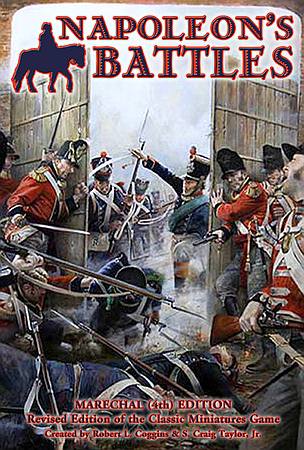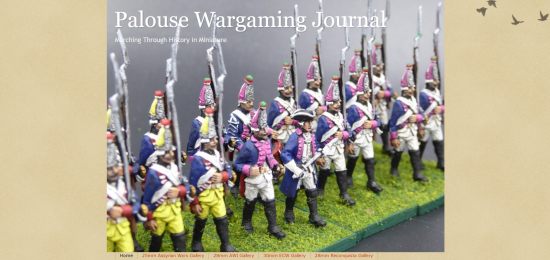
Marechal 4th Edition - Revised Edition of the Classic Miniatures Game
Total Votes: 23
Description
What the designers of Napoleon's Battles have attempted to create is a set of rules which allow one to recreate entire Napoleonic battles on a single tabletop, playable within an evening or so. Players are cast in the roles of corps commanders. The game is intended to balance historical accuracy with playability, while also producing a tabletop battle that looks panoramic.
The following description is based on the first edition of these rules.
The Basic Rules
The rules are presented in case format (numbered paragraphs). The game has several levels of play – basic, advanced (the so-called "standard game"), and with the optional rules. Players alternate taking turns. The turn's sequence of play is identical for each player, consisting of these phases –
| Control Phase | Leaders may attempt to rally their routed troops. Player checks leaders to see if they are within "command span" of their units. A unit beyond this range is "out of command." |
|---|---|
| Maneuver Phase | Friendly troops move, enemy cavalry then make reaction moves, followed by the reaction moves of friendly cavalry. Threatened infantry may attempt to form squares. Formation affects a unit's ability to move. |
| Fire Phase | All units which can fire must do so. Enemy troops fire first, then friendly troops. "Fire" represents artillery fire, skirmishers, and long-range musket volleys. Units fire individually. |
| Combat Phase | Close-range combat (including musket fire and hand-to-hand combat) is resolved now. Player selects the order in which attacks are resolved. Combat is mandatory. Attacks are broken down into matched pairs (one friendly unit, one enemy unit). |
| Pursuit Phase | Friendly cavalry may make reaction moves, followed by reaction moves of enemy cavalry. Limited firing occurs. Any close combats are resolved. |
Leaders play a major role, and stats are provided for dozens of historical leaders in this period. In the Basic Rules, leaders differ by command span (range at which they can control subordinates) and a close-combat modifier (a mandatory factor which applies to any combat involving that officer). Units which are "out of command" cannot move.
Cavalry has the special ability to, in effect, make bonus attacks during the turn. This occurs if the player can successfully "recall" the cavalry after their first attack; they may then make another attack.
The data charts individualize units by type, year, and nationality, so that there is a broad diversity in the ratings of the various stands. For instance, there are 23 types of French infantry. The result is that some units fight better than others, some fight more intelligently (that is, being more likely to form squares when needed), and some fight longer.
If a unit takes heavy losses in a single attack, it may become disordered (less effective) or it may rout (retreating from battle). Cumulative losses will cause a unit to become dispersed (it is removed from the tabletop, being no longer combat effective) or eliminated. If sufficient units become dispersed or routed, the army's morale will break and it will leave the battlefield.
The Advanced Rules
The advanced rules are intended to be used as a complete set, unlike the optional rules (see below). These rules are not very complex, and should be considered finishing touches added to the basic rules, rather than an entirely new level of play.
Most of the advanced rules simply add new wrinkles to the game. These include rules for reinforcements, all-out attacks by elite troops, dismounted cavalry, death for leaders, and evasion movement to avoid close combat. Artillery fire may set towns aflame. New modifiers apply to rout and disorder checks. Armies may continue to fight although broken, and may be rallied.
Disordered units in contact with the enemy must make a withdrawal attempt – this may result in further losses, an orderly movement away from the enemy, or a rout. Corps and divisions may become fatigued due to cumulative losses.
The Optional Rules
Once the Advanced Rules have been mastered, players are encouraged to pick and choose which of the optional rules they would like to use with their battles. The options include such rules modules as weather (fog might rise, or a storm break out), supply (units may run low on supplies, and wagons can be looted), hidden movement (units may be out of sight of the enemy), force marching (moving further at a cost in stragglers), construction and destruction of bridges and fortifications, and mass artillery (guns unlimbered hub-to-hub).
More complex rules are provided for long-range artillery fire. Special rules provide special bonuses for legendary leaders (Napoleon, Blucher, and so forth.). Messengers are introduced as a way for players on the same team to communicate with each other. An initiative marker is explained, which gives the player who holds it a number of special options – but if he uses that power, he must give the marker to his opponent. Similarly, a Free Roll marker is explained. Multi-day battles are explained.
The Scenarios
Maps and orders of battle are provided for six historical battles (Marengo, Auerstadt, Eylau, Talavera, Borodino, and Waterloo). Two fictional battles are provided as tools with which to learn the game. Labels may be photocopied from the scenario booklet to use in organizing units for battle.
In addition, the scenario booklet provides rules and charts for designing new scenarios. Armies and leaders are purchased using a point system.
Editions

The first edition, published by Avalon Hill, was a boxed game including rules booklet (36 pages), scenario booklet (48 pages), and background booklet (32 pages), 2 template cards, 12 information cards, 2 game cards, 2 decimal dice. The inclusion of 186 die-cut counters and 2 terrain cards allowed one to play immediately, without miniatures.
Supplements
There were two supplements for the first edition rules, both now out of print:
Napoleon's Battles Module

This 54-page booklet provided maps, labels, and orders of battle for an additional eight historical battles (Valmy, Friedland, Corunna, Aspern-Essling, Ocano, Salamanca, Leipzig, and Craonne), plus a fictitious scenario to be used when introducing players to large battles.
One page of errata for the original game (rules, scenarios, and information cards) is provided. New rules are provided for marsh and mud terrain. Optional rules cover skirmishing brigades, emergency changing from square to line formation, spread-out artillery units, and new options with the Initiative and Free Roll markers.
For designing your own scenarios, two new types of battles are explained. Charts are provided for point costs for early period armies (organized by divisions rather than corps).
Napoleon's Battles Expansion II
Expanded game with more generals, campaign rules, and five new scenarios.







